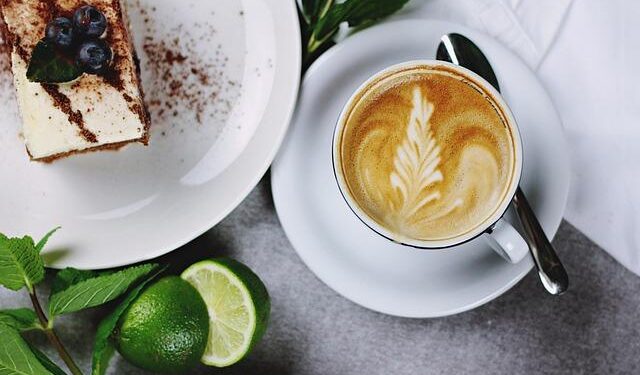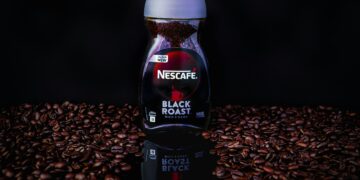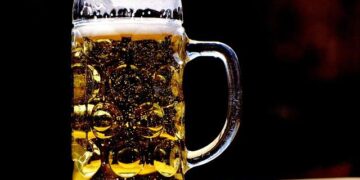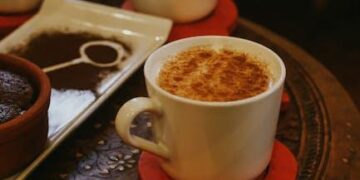Table of Contents
The Siren Song of a Flawed Masterpiece
I remember my first encounter with the Wendy’s Caramel Frosty Cream Cold Brew.
The name itself was a promise, a siren song of nostalgic comfort and modern craft.
It whispered of the thick, spoonable texture of a childhood Frosty, that iconic melted-ice-cream consistency, seamlessly blended with the sophisticated, invigorating kick of cold brew coffee.
It was a concept that felt both brilliantly simple and utterly decadent.
I pulled through the drive-through, full of anticipation for what I was sure would be my new obsession.
What I received, however, was a lesson in the vast chasm between a beautiful idea and inconsistent execution.
My experience, I soon learned from countless online forums and discussions, was far from unique.
One day, the drink would be a watery, vaguely coffee-flavored sugar bomb, so “obnoxiously sweet” that any hint of cold brew was completely annihilated.1
Another time, it would be shockingly bitter, a brew so harsh it tasted of “5 day old coffee pot coffee” or, in one particularly memorable description, like it was “mixed with rubbing alcohol”.2
The texture was a lottery; sometimes it was a homogenous, pale liquid, other times a disturbing concoction with a “weird brown liquid at the bottom” that had to “thicken up” for several minutes.3
And the caramel? More often than not, it was a phantom, an imposter that tasted more like artificial “butterscotch flavored coffee” than true, rich caramel.3
This inconsistency was maddening.
How could something with so much potential be so unreliable? It was this frustration that sparked a mission, a personal quest.
I vowed to deconstruct this flawed but promising concept and rebuild it from its foundational elements.
I would tame the bitter coffee, conquer the finicky caramel, and reverse-engineer that signature “Frosty” cream.
This guide is the chronicle of that journey—the failures, the breakthroughs, and the hard-won secrets.
It is the blueprint for transforming that inconsistent fast-food gamble into a reliable, balanced, and truly sublime beverage you can craft with confidence in your own kitchen.
Part I: The Destination — Your Perfect Caramel Frosty Cream Cold Brew Recipe
This is the culmination of the journey—the perfected recipe.
For those who wish to skip the story and get straight to the craft, your destination is here.
This is not just a drink; it’s a balanced symphony of three meticulously crafted components: a smooth, low-acid cold brew concentrate; a rich and buttery homemade salted caramel sauce; and a velvety, pourable “Frosty Cream” cold foam that perfectly captures the signature texture of melted ice cream.
- Yield: 1 serving
- Prep Time: 20 minutes
- Total Time: 12 to 24 hours (includes cold brew steeping time)
Equipment List
- Burr coffee grinder
- Large glass jar or pitcher (at least 1.5 liters)
- Fine-mesh sieve and coffee filters (or a dedicated cold brew maker)
- Kitchen scale
- Medium saucepan
- Candy thermometer
- Whisk
- Handheld milk frother
- Frothing pitcher or small jar
Ingredient List
For the Cold Brew Concentrate (1:8 Ratio)
- 125g Medium-Dark Roast Coffee Beans (Colombian Supremo recommended)
- 1000g (1 liter) Cold, Filtered Water
For the Salted Caramel Sauce (Yields approx. 1 cup)
- 200g (1 cup) Granulated White Sugar
- 60g (1/4 cup) Water
- 120g (1/2 cup) Heavy Cream, at room temperature
- 60g (4 tbsp) Unsalted Butter, cubed and at room temperature
- 5g (1 tsp) Vanilla Extract
- 3g (1/2 tsp) Flaky Sea Salt, or to taste
For the “Frosty Cream” Cold Foam (Single Serving)
- 45g (3 tbsp) Heavy Whipping Cream, cold
- 30g (2 tbsp) Whole Milk, cold
- 15g (1 tbsp) Homemade Salted Caramel Sauce, chilled
Step-by-Step Instructions
- Prepare the Cold Brew Concentrate (12-24 hours ahead):
- Using a burr grinder, grind the coffee beans to a medium-coarse consistency, similar to the texture of kosher salt.4
- In a large jar, combine the ground coffee and 1000g of cold, filtered water. Stir gently with a long spoon to ensure all grounds are saturated, with no dry pockets remaining.4
- Cover the jar and let it steep in the refrigerator for 12 to 24 hours. A longer steep will result in a stronger concentrate.
- After steeping, filter the concentrate. Line a fine-mesh sieve with a coffee filter (or use a cheesecloth) and place it over a clean pitcher or jar. Slowly pour the cold brew through the filter. This may take some time; do not force it. Discard the grounds. The resulting concentrate can be stored in an airtight container in the refrigerator for up to two weeks.5
- Prepare the Salted Caramel Sauce (Can be made days ahead):
- In a medium, heavy-bottomed saucepan, combine the 200g of sugar and 60g of water. Whisk until the sugar is fully saturated and resembles wet sand.
- Place the saucepan over medium heat. Let the mixture come to a boil without stirring. You can gently swirl the pan if you notice some areas coloring faster than others. To prevent crystallization, use a pastry brush dipped in water to wash down any sugar crystals that form on the sides of the pan.6
- Clip a candy thermometer to the side of the pan. Cook until the mixture turns a deep amber color and the thermometer reads between 340-350°F (170-175°C).7
- Immediately remove the pan from the heat. Very carefully and slowly, whisk in the room-temperature heavy cream. The mixture will bubble and steam violently—this is normal. Continue whisking until smooth.
- Whisk in the cubed, room-temperature butter one piece at a time until fully incorporated.
- Finally, stir in the vanilla extract and sea salt. Let the sauce cool completely in the pan before transferring to a jar. It will thicken significantly as it cools.8 The sauce can be stored in the refrigerator for up to a month.
- Assemble the Drink:
- Fill a 16oz glass with ice.
- Pour 120g (approx. 1/2 cup) of your cold brew concentrate over the ice.
- Add 120g (approx. 1/2 cup) of cold, filtered water to dilute the concentrate. If you prefer a creamier drink, you can use milk instead of water. Stir to combine.
- Prepare the Frosty Cream Cold Foam:
- In a small, chilled frothing pitcher or jar, combine the 45g of cold heavy whipping cream, 30g of cold whole milk, and 15g of your chilled homemade salted caramel sauce.9
- Submerge the head of a handheld milk frother into the mixture. Froth for 45-60 seconds. Move the frother up and down to incorporate air, then keep it submerged to create a fine-textured microfoam. The goal is a thick, pourable consistency similar to a melted milkshake—it should not form stiff peaks.10
- Finish the Drink:
- Gently and slowly pour the caramel frosty cream over the back of a spoon onto the surface of the cold brew. This will help it float on top, creating a distinct, beautiful layer.
- For an extra touch of decadence, drizzle a small amount of the remaining caramel sauce over the foam.
Part II: The Journey — Deconstructing the Masterpiece
The recipe you see above is not a first draft.
It is the survivor of countless failed experiments, the final product of a methodical deconstruction.
To truly master this drink and make it your own, you must understand the why behind each ingredient and every step.
The journey to perfection required breaking the beverage down into its three fundamental pillars: the Coffee, the Caramel, and the Cream.
In the sections that follow, I will guide you through my process of mastering each one, sharing the scientific principles, the culinary techniques, and the critical “aha!” moments that transformed a disappointing fast-food drink into a work of craft.
Part III: Pillar One – Mastering the Cold Brew Foundation
My first attempts at making cold brew at home were a disaster, mirroring the very complaints I had about the commercial version.
One batch, made with a fine grind, was a sludgy, acrid mess, overwhelmingly bitter and undrinkable.2
Another, steeped for too short a time, was weak and watery, tasting like sad, brown water.
It became clear that cold brew wasn’t just “coffee made with cold water”; it was a distinct extraction method governed by its own set of rules.
The foundation of our perfect drink had to be flawless, and that meant embarking on a quest to understand the bean, the grind, and the science of slow extraction.
The Bean Quest: Selecting Your Champion
The journey begins with the bean.
The type of coffee you choose will fundamentally define the character of your final drink.
My initial experiments with the light-roast, single-origin beans I loved for my morning pour-over were a mistake.
While celebrated for their bright, nuanced, and often fruity acidity, these characteristics become liabilities in a cold brew destined for dairy and caramel.
The resulting brew was often unpleasantly acidic or grassy, clashing horribly with the sweet and creamy elements.11
The breakthrough came when I shifted my focus to medium and dark roasts.
These roasts are prized for their lower acidity and more robust, foundational flavors—notes of chocolate, nuts, and caramel that shine through even when mixed with other ingredients.5
This isn’t just a matter of taste; it’s a matter of chemistry.
A high-acid coffee can react poorly with dairy, leading to curdling or a sour aftertaste.
A low-acid base is essential for a harmonious final product.
Through extensive testing of beans from various origins, a clear winner emerged: Latin America.
While African beans tended to be too fruity and floral, and Indonesian beans too earthy or spicy, coffees from Colombia, Guatemala, and Brazil consistently delivered the smooth, nutty, and chocolate-forward profile I was seeking.5
For this specific recipe, I wholeheartedly recommend a
Colombian Supremo.
These large, high-quality arabica beans, when given a medium-dark or dark roast, produce a beautifully balanced, full-bodied brew with classic chocolate notes and a smooth finish, making them the perfect team player in our trio of flavors.12
The Science of Extraction: Grind, Time, and Temperature
With the right bean selected, the next challenge was mastering the extraction process itself.
This is a delicate dance between three variables: grind size, steeping time, and temperature.
- The Grind is Everything: The size of your coffee grounds dictates the surface area available for water to extract flavor. Too fine a grind, and you get a bitter, over-extracted sludge that’s impossible to filter cleanly. The standard advice is a coarse grind, and for good reason. A uniform, coarse grind—about the size of kosher salt or coarse breadcrumbs—allows water to penetrate evenly without extracting the bitter compounds too quickly.4 However, my journey revealed a deeper nuance. Some experts suggest that a slightly finer grind than traditionally recommended—a
medium-coarse setting—can actually help pull out more of the desirable sugars, preventing the sourness that can sometimes plague cold brew.15 This is the sweet spot I aim for. - The Patience of Time: Cold brew extraction is a marathon, not a sprint. The cold water works much more slowly than hot water, requiring a long steeping time to achieve a full-flavored result. The ideal window is between 12 and 24 hours.12 Less than 12 hours often results in a weak, under-extracted brew. Pushing beyond 24 hours can risk re-introducing some of the bitter notes you worked so hard to avoid. I find the sweet spot for a rich, smooth concentrate to be around 18 hours.
- The Temperature Question: You have two primary options for steeping: at room temperature or in the refrigerator. While steeping on the counter is faster, my experiments have consistently led me to prefer the refrigerator method. The colder temperature provides a more controlled, forgiving, and slower extraction process. This consistently yields a smoother, cleaner, and less acidic final product, avoiding the slightly “over extracted” character that can sometimes come from a room-temperature steep.17
The Concentrate Revelation: Ratios and Dilution
This was perhaps the single most important “aha!” moment in my cold brew journey.
You are not brewing ready-to-drink coffee.
You are creating a coffee concentrate.
Thinking you can drink the initial brew straight is a common mistake that leads to an overwhelmingly strong experience, aptly described by one source as tasting like “motor oil mixed with jet fuel”.15
The key to consistency is a fixed brew ratio, measured by weight for accuracy.
I recommend a starting ratio of 1:8—that is, 1 gram of coffee for every 8 grams of water.4
This creates a potent but balanced concentrate.
The final, crucial step is dilution.
This is where you transform the potent concentrate into a perfectly drinkable coffee.
The ideal dilution ratio is a matter of personal preference, but a 1:1 ratio (equal parts concentrate to water or milk) is the gold standard for a final brew strength that is familiar and satisfying to most palates.4
This two-step process—brew a concentrate, then dilute—is the secret to achieving a perfectly balanced and repeatable cold brew foundation every single time.
| Table 1: Cold Brew Concentrate & Dilution Guide | |||
| Coffee:Water Ratio (Brewing) | Resulting Strength | Recommended Dilution (Concentrate:Water/Milk) | Best For |
| 1:4 | Very Strong Concentrate | 1:2 or 1:3 | Espresso-like drinks; those who prefer very strong coffee. |
| 1:8 (Recommended) | Standard Concentrate | 1:1 | The perfect balance for this recipe and most iced coffee applications. |
| 1:12 | Ready-to-Drink | None (or just add ice) | A lighter, ready-to-drink cold brew without the need for dilution. |
Part IV: Pillar Two – Conquering the Caramel Conundrum
With a flawless coffee base established, the next pillar to master was the caramel.
This is where the drink gets its soul and its name.
My initial impulse, like many home baristas, was to take the easy route: store-bought syrups and sauces.
This detour taught me a valuable lesson.
The Store-Bought Detour vs. The Homemade Dream
Commercial coffee syrups, like those from Torani or Monin, are convenient.
They come in easy-to-use squeeze bottles and offer consistent flavor.19
However, they are fundamentally thin, water-and-sugar-based liquids.
They often lack the depth and richness of true caramel and can impart a one-dimensional, sometimes artificial sweetness.
Store-bought caramel sauces, like those from Ghirardelli, are a step up.
They are thicker, more buttery, and taste more like they belong in a coffee drink.21
But even the best store-bought sauce cannot compare to the profound flavor, luxurious texture, and complete control you get from making it yourself.
To achieve the “perfect” drink, where the caramel is a star player and not just a sweetener, homemade is the only path.
The Alchemist’s Art: Caramel Chemistry in Your Kitchen
Making caramel can feel like a daunting act of alchemy, but it’s really just applied chemistry.
My journey to conquer it involved understanding the science behind the process.
- Wet vs. Dry Caramel: There are two main methods for making caramel: dry (melting sugar by itself) and wet (dissolving sugar in water first).8 While the dry method is faster, it is notoriously prone to burning and crystallizing. For consistency and control, I exclusively use the
wet caramel method. The water helps the sugar melt evenly, giving you a much larger margin for error. - The Non-Negotiable Thermometer: If you want repeatable results, a candy thermometer is not optional. Caramel’s final texture is dictated entirely by the temperature to which it is cooked.22 A few degrees can be the difference between a pourable sauce and a hard, tooth-breaking candy. Cooking the sugar syrup to a precise temperature between 340-350°F (170-175°C) is the key to achieving that perfect deep amber color and rich, complex flavor every time.7
- The Science of the Sauce: The process is a beautiful transformation. First, you cook the sugar and water, evaporating the water and causing the sugar molecules to break down and reform in a process called caramelization. This creates the color and flavor. The critical moment is when you stop the cooking by adding fat—in our case, heavy cream and butter. This is what transforms the molten sugar from a future hard candy into a rich, decadent sauce. This distinction is vital: a syrup is just sugar and water, while a sauce is an emulsion of sugar and fat.8 This fat-based structure is essential for our drink, as it allows the caramel to integrate smoothly into the cold, dairy-based foam rather than sinking to the bottom as a dense, sugary layer.24
- The Butterscotch vs. Caramel Mystery Solved: This brings me to a crucial discovery that solved one of the biggest complaints about the commercial drink: the “butterscotch” flavor.3 The difference is simple but profound. True caramel is made from caramelizing
white sugar. Butterscotch is made with brown sugar, which contains molasses.3 That molasses is what gives butterscotch its distinct, deeper flavor. The recipe in this guide uses only white sugar to ensure you are creating a pure, unadulterated, true caramel flavor.
A Troubleshooter’s Guide to Liquid Gold
Caramel is known for being finicky.
Over the years, I’ve encountered every possible failure, and I’ve learned how to fix—or at least understand—most of them.
This knowledge turns potential frustration into a valuable learning experience.
| Table 2: Caramel Sauce Troubleshooting Guide | ||
| Problem | Likely Cause | The Fix |
| Too Runny / Thin | The sauce was not cooked to a high enough temperature, or there is too much liquid (cream/water) in the ratio.8 | Let the sauce cool completely first to see its final consistency. If still too thin, return it to the saucepan over low heat and simmer gently for 5-10 more minutes to evaporate excess water, then cool again.25 |
| Too Thick / Hardens When Cool | The sauce was cooked to too high a temperature, past the “sauce” stage and into the “soft candy” stage.7 | Gently reheat the sauce in a pan over low heat. Whisk in a tablespoon or two of additional heavy cream until it reaches your desired consistency. Be careful not to boil it again.7 |
| Grainy or Crystallized | Sugar crystals from the side of the pan fell back into the syrup, causing a chain reaction of crystallization.6 | Prevention is the best cure. During the initial boiling, use a clean pastry brush dipped in water to wash down the sides of the pan. Unfortunately, once it’s fully crystallized, it’s best to start over. |
| Burnt or Bitter Taste | The sugar was cooked for too long or at too high a heat. Caramel can go from perfect to burnt in a matter of seconds.7 | There is no fix for burnt caramel. The bitter flavor will permeate the entire batch. Discard it, clean the pan thoroughly, and start again, watching it more closely. |
| Separated or Oily | The emulsion broke, often because the cream or butter was too cold when added, or it was whisked too aggressively. | Try gently reheating the sauce over very low heat while whisking constantly. Sometimes this can bring the emulsion back together. If not, you may need to start over. |
Part V: Pillar Three – Achieving the Signature “Frosty Cream”
The final pillar, the “Frosty Cream,” is the element that elevates this drink from a simple iced coffee to something special.
It’s the crown jewel, and getting it right was the most scientifically demanding part of the journey.
My first attempts were a comedy of errors.
I created foams that were thin and bubbly, disappearing into the coffee in seconds, just as some users described.26
Then I would overcompensate, over-whipping the mixture into a stiff, un-pourable whipped cream that sat on top of the coffee like a solid dollop, a common pitfall warned about by experienced baristas.9
The path to that perfect, velvety, pourable foam—the texture of a melted Frosty—lies in understanding the delicate science of milk.
The Unseen Science of a Perfect Foam
A stable, luxurious foam is a balancing act between three elements: protein, fat, and temperature.
- Protein, Fat, and Temperature: The Holy Trinity: The structure of any milk foam is built by proteins, specifically casein and whey. When you agitate milk by frothing, these proteins unravel and wrap themselves around the air bubbles you’re introducing, creating a protective film that prevents the bubbles from bursting.27
Fat, on the other hand, plays a dual role. It is the key to a creamy, rich mouthfeel and a supple texture. However, fat molecules can also get in the way of the proteins, destabilizing the foam and preventing it from becoming light and airy.29 Finally,
temperature is paramount. For a stable cold foam, all your ingredients must be very cold (around 39°F/4°C).30 When milk fat is cold, the fat globules are solid and interfere less with the protein network, allowing for a more stable foam to form.29 Warm milk simply will not froth well into a cold foam.31 - The Skim Milk Myth vs. Creamy Reality: You will find conflicting advice on the best milk for frothing. Some sources claim skim milk works best because its high protein-to-fat ratio creates the most voluminous, stable foam.32 And for a light, airy, dry foam (like for a traditional cappuccino), this is true. However, that is the
opposite of the texture we want. We are not aiming for maximum volume; we are engineering a specific texture: the rich, dense, velvety creaminess of a melted Frosty. This requires fat. Whole milk and heavy cream are the choice for creating a supple, flowing, creamy foam.27 The name of the drink is our guide: “Frosty Cream.” To replicate that, a high-fat foam is not just an option, it’s a requirement.
The “Frosty Cream” Formula: A Study in Ratios
The secret to that signature texture lies in a precise ratio of heavy cream to milk.
After experimenting with various formulas, from a milk-heavy 1:2 cream-to-milk ratio 34 to an equal-parts blend, I landed on the perfect formula, one championed by former baristas for its rich yet pourable consistency.9
The perfected formula is 3 parts heavy whipping cream to 2 parts whole milk, measured by weight or volume.
This ratio is a deliberate feat of engineering.
The high proportion of heavy cream provides the necessary butterfat to create that luxurious, velvety, dense texture that mimics a Frosty.
The whole milk, with its lower fat and higher water content, thins the mixture just enough so that it remains a pourable foam rather than seizing up into stiff whipped cream.
It also contributes additional proteins that help with stabilization.
This balance is the key to the entire experience.
Frothing Finesse: Technique and Tools
You do not need a fancy espresso machine to create this foam.
A simple, inexpensive handheld milk frother is the perfect tool for the job.
But technique matters.
First, combine your cold cream, cold milk, and chilled caramel sauce in a frothing pitcher.
Start by moving the frother up and down near the surface to incorporate air and build volume.33
Once it begins to thicken, submerge the frother deeper into the liquid.
This creates a vortex that breaks down the larger, unstable bubbles into a fine, silky microfoam, which is key for a creamy texture.
The most critical tip I can offer is this: froth for time, not just appearance.
A common mistake is to stop as soon as the mixture looks foamy.
For a truly thick and stable foam, you must continue frothing for at least 45 to 60 seconds.10
This extended agitation ensures the proteins have fully unraveled and stabilized the air bubbles, resulting in a foam that holds its shape beautifully as it cascades into your coffee.
| Table 3: Cold Foam Troubleshooting Guide | ||
| Problem | The Scientific Reason | The Fix |
| Foam is thin/watery | Ingredients were not cold enough. Fat globules are partially liquid at warmer temperatures, which destabilizes the protein network.29 Insufficient fat content. | Chill all ingredients (cream, milk, sauce) and the frothing pitcher thoroughly before starting. Use heavy whipping cream and whole milk as specified. |
| Foam collapses quickly | The protein structure is weak. This can be due to a poor fat/protein balance or the age of the milk, as older milk can have higher levels of free fatty acids from lipolysis, which destroy foam.27 | Ensure your dairy is fresh. Try a different brand of milk or cream, as processing methods can affect protein content.27 Ensure you are frothing long enough (45-60 seconds). |
| Foam is too thick/like whipped cream | Over-aeration. You’ve incorporated too much air and the fat globules have started to clump together, essentially creating whipped cream.9 | Froth for less time. Stop as soon as the mixture reaches a thick, pourable, “melted milkshake” consistency, before it forms distinct peaks. |
| Foam is bubbly, not creamy | The air bubbles are too large and not uniformly integrated into the liquid, creating a “bubble bath” texture. | After the initial aeration near the surface, submerge the frother deeper into the liquid to create a whirlpool. This breaks down large bubbles into a smoother microfoam. After frothing, gently tap the pitcher on the counter and swirl it to further homogenize the foam.30 |
Part VI: The Grand Assembly – Building Your Masterpiece
You have conquered the three pillars.
The smooth cold brew, the rich caramel, and the velvety frosty cream are ready.
Now, for the final, rewarding act: the grand assembly.
This is where art meets science, creating a symphony in a glass.
The Art of Layering
The order of operations is crucial for a beautiful, layered presentation.
Always begin by filling your serving glass with i.e. This chills the glass and provides a foundation.
Next, pour in your diluted cold brew concentrate.
The cold liquid settling around the ice sets the stage for the final flourish.
The Perfect Pour
To create that stunning, distinct layer of cream floating on top of the coffee, do not simply dump the foam in.
Use the back of a spoon.
Hold a spoon just above the surface of the coffee and slowly pour the Frosty Cream over the back of it.
This technique breaks the fall of the foam, allowing it to spread gently across the surface of the drink instead of plunging into it.
It’s a simple barista trick that makes a world of difference in the final presentation.
Final Flourishes
The drink is nearly complete, but a final touch can elevate it further.
Take your homemade caramel sauce and drizzle a small amount in a pattern over the top of the foam.
For a final sensory kick that enhances all the flavors, add a tiny pinch of flaky sea salt over the caramel drizzle.
This not only looks professional but also provides a delightful burst of flavor that cuts through the richness and makes the caramel and coffee notes sing.
Conclusion: Your Journey Begins
What began as a quest to fix a flawed fast-food drink has become a deep dive into the craft of beverage making.
We’ve learned that the secret to a perfect Caramel Frosty Cream Cold Brew isn’t a single magic ingredient, but a harmony of three meticulously prepared components.
It’s built on the core principles of a smooth, low-acid coffee foundation that plays well with others; the precise, temperature-controlled chemistry of a true, fat-based caramel sauce; and the scientific balance of protein, fat, and cold in an engineered “Frosty” foam.
This guide is more than a rigid set of instructions; it is a foundation of understanding.
You now possess the knowledge not just to replicate this recipe, but to make it your own.
You understand why a Colombian bean works better than an Ethiopian, why a candy thermometer is your best friend, and why your cream must be ice-cold.
This is where my journey ends and yours begins.
Use this knowledge to experiment with confidence.
Try a different Latin American coffee bean.
Infuse your caramel with cinnamon or a hint of bourbon.3
Create a mocha-flavored foam or a vanilla bean version.
You have moved from a frustrated consumer to a master craftsman.
The canvas is yours.
Happy brewing.
Works cited
- You guys really like the Frosty Cream Cold Brew? : r/wendys – Reddit, accessed July 18, 2025, https://www.reddit.com/r/wendys/comments/1772pcl/you_guys_really_like_the_frosty_cream_cold_brew/
- Frosty cold brew : r/wendys – Reddit, accessed July 18, 2025, https://www.reddit.com/r/wendys/comments/1k98br1/frosty_cold_brew/
- Salted Caramel Frosty Review (Horrible) : r/wendys – Reddit, accessed July 18, 2025, https://www.reddit.com/r/wendys/comments/1h8a46z/salted_caramel_frosty_review_horrible/
- The Ultimate Guide on Making Cold Brew Coffee Concentrate – Sunday Table, accessed July 18, 2025, https://sundaytable.co/cold-brew-coffee-concentrate/
- What Are the Best Coffee Beans for Cold Brew?, accessed July 18, 2025, https://www.ictcoffee.com/news/what-are-the-best-coffee-beans-for-cold-brew/
- What’s a good way to “thicken” a caramel sauce so it swirls throughout my homemade ice cream? It’s a little too “liquidy” currently, even after freezing. – Quora, accessed July 18, 2025, https://www.quora.com/What-s-a-good-way-to-thicken-a-caramel-sauce-so-it-swirls-throughout-my-homemade-ice-cream-It-s-a-little-too-liquidy-currently-even-after-freezing
- I always make caramel sauce but it becomes thick and unpourable after cooling down, so I would appreciate if you can… – Food52, accessed July 18, 2025, https://food52.com/hotline/771-i-always-make-caramel-sauce-but-it-becomes-thick-and-unpourable-after-cooling-down-so-i-would-apprec
- How to Thicken Caramel Sauce: 4 Tips for Thick Caramel Sauce – 2025 – MasterClass, accessed July 18, 2025, https://www.masterclass.com/articles/how-to-thicken-caramel-sauce
- Single serve cold foam recipe. (Former barista) : r/starbucks – Reddit, accessed July 18, 2025, https://www.reddit.com/r/starbucks/comments/py4y1o/single_serve_cold_foam_recipe_former_barista/
- how to make perfect cold foam – YouTube, accessed July 18, 2025, https://www.youtube.com/shorts/4KO3h8efS2c
- The Best Coffee for Cold Brew with a Recipe – Braised & Deglazed, accessed July 18, 2025, https://braisedanddeglazed.com/the-best-coffee-for-cold-brew-with-a-recipe/
- Best Coffee Beans for Cold Brew – Blends and Single Origin, accessed July 18, 2025, https://thatscoldbrew.com/best-coffee-for-cold-brew/
- What are your favorite coffees for cold brew? – Reddit, accessed July 18, 2025, https://www.reddit.com/r/Coffee/comments/etgbr7/what_are_your_favorite_coffees_for_cold_brew/
- Cold Brew Reserve – Stone Street Coffee, accessed July 18, 2025, https://stonestreetcoffee.com/products/regular-cold-brew
- Guide To Cold Brew – Counter Culture Coffee, accessed July 18, 2025, https://counterculturecoffee.com/blogs/counter-culture-coffee/guide-to-cold-brew
- Salted Caramel Cream Cold Brew : r/recipes – Reddit, accessed July 18, 2025, https://www.reddit.com/r/recipes/comments/tqedj4/salted_caramel_cream_cold_brew/
- Best Ratio for Cold Brew? : r/Coffee – Reddit, accessed July 18, 2025, https://www.reddit.com/r/Coffee/comments/w62ewa/best_ratio_for_cold_brew/
- counterculturecoffee.com, accessed July 18, 2025, https://counterculturecoffee.com/blogs/counter-culture-coffee/guide-to-cold-brew#:~:text=Most%20people%20prefer%20to%20drink,brew%20familiar%20to%20most%20folks.
- Homemade vs. Store-Bought Coffee Syrups: Which Is Better for Your Brew? – Syruvia, accessed July 18, 2025, https://syruvia.com/blogs/blog-posts/homemade-vs-store-bought-coffee-syrups-which-is-better-for-your-brew
- Syrup Showdown: Caramel Syrup. Do you prefer caramel sauce or syrup?! – TikTok, accessed July 18, 2025, https://www.tiktok.com/@alexhomebarista/video/7232719761560358187
- Best Caramel Sauce for Coffee, Ice Cream, and Eating Straight Off the Spoon – Sporked, accessed July 18, 2025, https://sporked.com/article/best-caramel-sauce/
- Salted caramel too runny : r/AskBaking – Reddit, accessed July 18, 2025, https://www.reddit.com/r/AskBaking/comments/nm3366/salted_caramel_too_runny/
- Homemade vs storebought caramel : r/AskBaking – Reddit, accessed July 18, 2025, https://www.reddit.com/r/AskBaking/comments/1bvrevr/homemade_vs_storebought_caramel/
- Caramel Sauce vs Caramel Syrup – Seasoned Advice – Stack Exchange, accessed July 18, 2025, https://cooking.stackexchange.com/questions/102881/caramel-sauce-vs-caramel-syrup
- How to Make Caramel Sauce Thicker – YouTube, accessed July 18, 2025, https://www.youtube.com/watch?v=l49Ewxvnw5E&pp=0gcJCfwAo7VqN5tD
- Starbucks Cold Foam at Home: Easy Recipe – TikTok, accessed July 18, 2025, https://www.tiktok.com/@ilhanm.a/video/7307009496633642272
- The Facts about Milk Foam – Ricardo Cuisine, accessed July 18, 2025, https://www.ricardocuisine.com/en/articles/food-chemistry/521-the-facts-about-milk-foam
- Why won’t my milk foam: Here is what you need to know about the chemistry of milk steaming – Comunicaffe International, accessed July 18, 2025, https://www.comunicaffe.com/why-wont-my-milk-foam-all-you-have-to-know-about-the-chemistry-of-milk-steaming/
- There’s a Science Behind Milk Foams (Latte Art) – FoodCrumbles, accessed July 18, 2025, https://foodcrumbles.com/how-to-make-milk-foam-for-coffees/
- The Art of Latte Art-The Science Behind Milk Foam Stability – Wirsh, accessed July 18, 2025, https://mywirsh.com/blogs/coffee-facts/the-art-of-latte-art-the-science-behind-milk-foam-stability
- Why Is My Milk Not Frothing? – YouTube, accessed July 18, 2025, https://www.youtube.com/watch?v=yU793W9C-gs
- Why doesn’t the milk froth properly? – Mr. Coffee, accessed July 18, 2025, https://help.mrcoffee.com/s/article/Why-doesnt-the-milk-froth-properly
- Why isn’t my milk frothing properly? : r/AskCulinary – Reddit, accessed July 18, 2025, https://www.reddit.com/r/AskCulinary/comments/17dehet/why_isnt_my_milk_frothing_properly/
- Sweet Cream Cold Foam – Budget Bytes, accessed July 18, 2025, https://www.budgetbytes.com/sweet-cream-cold-foam/






